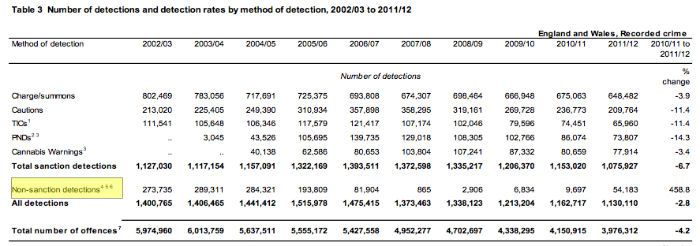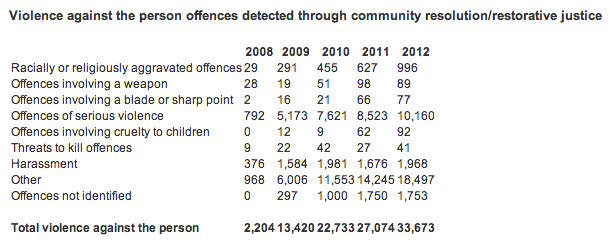Are austerity cuts allowing criminals to get away with violent offences?
"Police forces are dealing with up to 14% of violent crimes against the person through "community resolutions" as police cuts bite and the number of officers falls. FOIs show a steep increase in serious offences - including domestic violence and knife crime - being dealt with by community resolutions since cuts started in 2010."
Yvette Cooper, Labour Party press release, 30 April 2013
Has the police gone soft? The Labour party argues that police officers are taking an overly lenient approach to serious crime, increasingly opting for 'community resolutions' for offences including domestic violence and knife crime.
In an article on Labour's statistics, which were obtained by sending out an FOI request to all police forces in the country, the Daily Mail reported that police are letting off "more than 10,000 seriously violent criminals because they said 'sorry' to their victims." Is it really that simple?
What is a 'community resolution'?
A community resolution is an alternative way of tackling minor crime, through which the offender avoids going to court if they agree to make amends to the victim by apologising, compensating them, or by repairing any damage. It is generally used for offences such as low level public disorder, criminal damage, theft, or minor assaults.
As the assistant chief constable of Greater Manchester Police told the Today Programme yesterday morning, for a community resolution to be issued three conditions must be met: it has to be a low-harm offence, the offender has to accept the guilt and there has to be consent from the victim. The last point is vital: community resolutions were designed to be 'victim-led'.
Crucially, they can be carried out via either a sanction detection or a non-sanction detection. The User Guide to Home Office Statistics defines sanction detections as a police method to count crime where offences are resolved through a formal sanction - such as being charged or receiving a caution. Not all sanction detections lead to a conviction, though. In cases where a defendant is charged the Crown Prosecution Service (CPS) may not decide to proceed with the case and the defendant can always be found not guilty.
With a non-sanction detection, the offender receives more lenient treatment: the sentence is cleared and they avoid a criminal record as well as going to court. Labour's FOI specifically sought out offences of violence against the person which had been detected through a non-sanction detection. According to the Crime Survey (page 10), in 2011/12 the number of non-sanction detections accounted for fewer than five per cent of all detections.
In 2007 the Government introduced new rules on non-sanction detections (see page 150). Since then, there are only two reasons for a non-sanction detection: the offender dies before proceedings are completed or the CPS decides not to prosecute even when they are satisfied there is enough evidence to provide a realistic chance of conviction.
This change in policy is reflected in the table below, taken from the 2011/12 Crime Survey (page 22). The Crime Survey states that the new rules governing non-sanction detections "significantly limited the occasions for which such administrative disposals can be applied," which would explain a drop in numbers in 2007/8. As we can see this was followed by a new increase in the use of non-sanction detections.

Labour's FOI
Police forces across the country were sent the following question:
"How many offences of violence against the person were detected through a non-sanction detection using restorative justice and community resolution, broken down by offence description, in the following years: 2008; 2009; 2010; 2011; 2012?"
Out of 43 police forces, 31 replied. Yvette Cooper's office collated the responses and sent them to the House of Commons Library to analyse. The outcome is found in the table below:

The number of community resolutions issued for violent crime by 31 police forces jumped from 2,204 in 2008 to 33,673 in 2012, which equates to a fifteen-fold increase, as the Daily Mail noted. In the last year alone 10,160 offences of serious violence involving injury were resolved with a non-sanction detection. This increase certainly raises eyebrows. How can we explain it?
What's behind the rise in community resolutions?
The Labour party argues a "steep increase" in serious offences being dealt with by community resolutions has happened as a result of post-2010 cuts to police forces nation-wide, which led to fewer police officers on the beat. It's true that diverting first-time offenders away from the courts system results in substantial cost savings. But could there be more to it?
Although there's been a fifteen-fold increase in the use of community resolutions since 2008, the biggest increase is between 2008 and 2009. After 2009, the increase is smaller. In other words, the largest year-on-year rise in the number of community resolutions occurred before the Coalition assumed office and the cuts began to bite.
Community resolutions are new
One potential reason behind the rise is that community resolutions are a fairly new method of policing in many parts of the country. Some police forces - such as Avon and Somerset or Northumbria - which published their FOI responses hereand here respectively - started using community resolutions in 2009. Others, like Nottinghamshire Police and Sussex Police introduced them in 2011. This goes some way towards explaining why the figures for 2008 are so low.
But there's more to it.
Some are targeted at young people
In 2008/09 and 2009/10 a number of police forces started piloting youth restorative disposals (YRDs), which allow officers to deal with low-level crime and neighbourhood disorder where it's not considered to be in the public interest to prosecute. This is partly because, according to Ministry of Justice research, young people are less likely to reoffend when they participate in restorative justice.
Youth restorative disposals are non-sanction detections which are offered to minors aged 10 to 17. The fact that they're targeted at minors may explain why so many non-sanction detections are being used for violent offences. Labour took issue with this precise point.
Should we blame the government?
The extent to which we can see this as an issue relating to government policy is debatable. A Home Office report on recorded crime outcomes suggests that the Home Office only started receiving data on crimes 'cleared up' by the application of local community resolution or restorative justice disposals in April 2011, when 22 police forces started sending them data on recorded non-sanction detections on a voluntary basis. This was designed to address the fact that the previous framework did not recognise and keep track of informal disposals.
What about domestic violence?
Labour have objected to the fact that community resolutions are being used to target domestic violence incidents. They say that this goes against guidance issued by the Association of Chief Police Officers (ACPO). The party made a separate FOI request for these type of offences, and received responses from just 13 police forces. They found that from 2009 to 2012, the number of domestic violence incidents detected without sanction rose from 373 to 2,488 in 2012.
As Yvette Cooper points out in her press release, the low response turnout and the low figures can be explained by the fact that "many forces don't record domestic violence separately", but rather file it under "violent offence".
Furthermore, the assistant chief constable of Greater Manchester Police told the Today Programme yesterday that recording domestic violence is particularly problematic as victims aren't always keen to give consent to the police to record the crime, and given their relation to the offender, are more prone to resolving the issue informally.
Conclusion
If we are willing to assume that the 31 police forces that did reply to the FOI requests are representative of the 43 police forces nationally, the figures cited by the Labour party are sound, and it's fair to conclude that there has been a rise in the number of community resolutions. However, there is little evidence linking this increase directly to the austerity cuts. Trends since 2008 show that there may well be other factors in play. A number of police forces only started employing community resolutions after 2008, 2009 and in some cases 2011. New schemes to target youth crime were also introduced in that time frame.
---
Flickr image courtesy of Jesse Loughborough